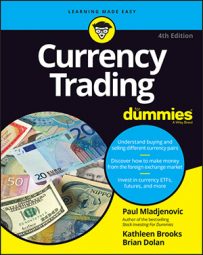Depending on the trade setup, you may be entirely justified in averaging into a position. In fact, with some trade opportunities, you’ll be hoping to have the chance to average into the position at better rates, because if the trade setup is correct, you’ll want to have on as large a position as possible.
Even though certain trade opportunities warrant averaging into a position, you still need to identify the ultimate stop-loss exit point in every trade setup. In other words, you can average into a position as much as you want up to a certain point, but after that the trade setup is invalidated, and you need to exit the position.
These trade setups are those where a reversal is anticipated. Prices frequently move into counter-trend consolidation ranges, where prices move in the opposite direction of the primary trend for a time before the trend resumes. You may see signs of an impending reversal from daily candlestick patterns, such as a shooting star/hammer or a tweezers top/bottom.
You may begin to suspect a reversal after a significant intraday spike reversal/rejection from key technical levels. The market may also be nearing important long-term trend-line support or resistance that suggests a medium-term bottom or top is close by.
What all these setups have in common is a price difference between current market levels and the ideal entry point based on the setup. For example, major daily trend-line resistance dating back six months may lie above in EUR/USD at 1.2960/70. Current market levels are well below at 1.2890, and there has been a spike rejection from an intraday test to 1.2930/35.
Adding up these observations, we may justifiably conclude that the current market price is just below an area of major resistance, suggesting a short position as the overall way to proceed.
But you have no accurate way of predicting how much higher the market might trade, or even if it will, before the anticipated reversal lower takes place. The market could start moving directly lower from current levels. It could retest the spike highs seen earlier in the day, or it could make it all the way to test the key trend-line resistance before stalling. So where might you look to get short?
The answer is in that zone of resistance we just identified between current market levels and the daily trend-line resistance. This is where it makes sense to average into a trade to exploit the trade setup.
As an example of this approach, you may not know how much higher the market will go, so you may be prepared to short a portion of the overall position at current market levels, in case the top has already been seen and prices move directly lower.
You may also be prepared to sell remaining portion(s) of the position at successively higher levels, if the market allows it. Save the last portion of the position for the trend-line resistance level in case it’s reached.
When considering where to leave your limit-entry orders to average into a trade, be aware of what your final average rate will be if all your orders are filled. The difference between that average rate and your stop-loss level multiplied by the total position size will give you the total amount you’re risking on the trade.
Although there are no 100-percent accurate gauges to tell you how much higher the market is likely to trade, you can use short-term momentum studies — such as stochastic models, the Relative Strength Index (RSI), or Moving Average Convergence/Divergence (MACD) — to make an educated guess as to how much more upside potential there may be.
If hourly momentum studies have already topped out and crossed over to the downside, for example, the upside potential is likely more limited. This may argue for being more aggressive in establishing a short position, such as making the initial sale at current market levels and placing any additional limit orders to sell above at closer levels. But if hourly momentum studies are still moving higher, you can reasonably wait and look to sell at relatively higher levels using limit sell orders.
Averaging into a reversal setup requires that you’re able to buy/sell multiple lots over relatively large price zones, sometimes as much as 100 pips or more. Make sure that you have sufficient margin resources available before you start averaging into your overall position. Depending on the size of the buy/sell zone and your available margin balance, you may have to space your limit-entry orders farther apart or trade fewer lots overall.
It’s always a trade-off between being in the right position to catch the move and getting in at the best price possible. It’s quite frustrating to identify a potentially significant market reversal, leave a single limit-entry order, but then see the reversal take place without your order being filled. Averaging into the position starting at current prices is one way to make sure you’re on board for at least some of the move.
If the setup works out, you’ll have taken advantage of any favorable price moves the market has made, resulting in a better average rate on your position. If the setup fails, averaging into the position at successively better rates will cost less in the end than entering the whole position at the current market level.

